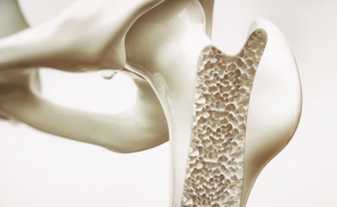 Osteoporosis is a systemic bone disease in which bone density and bone quality are reduced due to various reasons, the bone microstructure is destroyed, and bone fragility is increased, which is prone to fractures. Osteoporosis is divided into two categories: primary and secondary. Primary osteoporosis is divided into three types: postmenopausal osteoporosis (type Ⅰ), senile osteoporosis (type Ⅱ), and idiopathic osteoporosis (including juvenile type). Osteoporosis is a metabolic bone disease, which is mainly caused by decreased bone formation and increased bone resorption. Mild patients have no obvious symptoms. As the disease progresses, the patient feels fatigued, waist back is easy to ache, and even bone pain throughout the body. Fractures are more likely to occur when falling. Severe osteoporosis can also cause body deformation such as hunchback.
Osteoporosis is a systemic bone disease in which bone density and bone quality are reduced due to various reasons, the bone microstructure is destroyed, and bone fragility is increased, which is prone to fractures. Osteoporosis is divided into two categories: primary and secondary. Primary osteoporosis is divided into three types: postmenopausal osteoporosis (type Ⅰ), senile osteoporosis (type Ⅱ), and idiopathic osteoporosis (including juvenile type). Osteoporosis is a metabolic bone disease, which is mainly caused by decreased bone formation and increased bone resorption. Mild patients have no obvious symptoms. As the disease progresses, the patient feels fatigued, waist back is easy to ache, and even bone pain throughout the body. Fractures are more likely to occur when falling. Severe osteoporosis can also cause body deformation such as hunchback.
The goals for the evaluation of patients at risk for osteoporosis are to establish the diagnosis of osteoporosis on the basis of assessment of bone mass, to establish the fracture risk, and to make decisions regarding the need for instituting therapy. The medical history and physical examination are essential to assess the risk of fractures, and should include an assessment of height drop and posture changes. When osteoporosis is diagnosed, laboratory evaluation of the secondary causes of osteoporosis should be considered. The most commonly used measurement method for diagnosing osteoporosis and predicting fracture risk is based on the assessment of BMD (bone mineral density), which is mainly determined by the mineral content of bone. BMD measurement has been shown to be closely related to the carrying capacity of the hip and spine and the risk of fracture. The WHO stipulates that the diagnosis of osteoporosis should use dual-energy X-ray bone mineral density measurement to measure BMD, which can diagnose the disease, predict the risk of fracture, and evaluate the effect of drug therapy.
While the in vivo function of osteocalcin is unknown, its affinity for bone mineral constituents implies a role in bone formation. Creative Biogene’s kit measures serum osteocalcin levels through immunoassays to help diagnose osteoporosis. Our products can help you obtain high-precision and high-reproducibility results, so that you can quickly achieve your research goals.
Creative Biogene focuses on the field of diagnostic reagents for osteoporosis gravis. It is sincerely looking forward to cooperating with you and providing you with the best quality product with all of our hearts! We look forward to working with you for your cooperation.
Please contact us for more details.
Reference
| Cat# | Product Name | Product Type | Inquiry |
|---|---|---|---|
| C1328T | 25-OH Vitamin D ELISA test | Test kit | Inquiry |
| C1329T | BAP ELISA test | Test kit | Inquiry |
| C1330T | DPD ELISA test | Test kit | Inquiry |
| C1331T | PYD ELISA test | Test kit | Inquiry |
Copyright © 2026 Creative Biogene. All rights reserved.